Louise Rusch
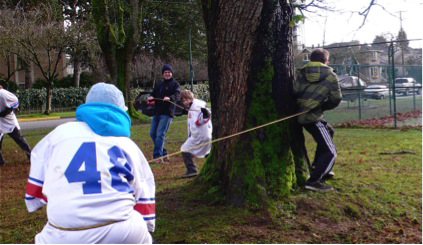
Germaine Koh. League, ongoing since 2012, Participatory Project. Image courtesy the artist.
League, Germaine Koh’s ongoing game-invention project, is based in Vancouver’s Elm Park field house, originally the park caretaker’s residence. Everyone enters through the front door into an area with a couch, seating cubes, chairs and tables. The mise-en-scène mixes a public studio space with an intimate home atmosphere. As a participant, my instinct is to acclimatize as I wrestle with a range of emotions from curiosity to vulnerability. There are hot drinks and cookies on the counter, and the table on the left contains a super-sized tool box, the ‘League Home Edition Kit’. Inside, each tray is filled with a menagerie of items: toys, dice, pieces of wood, paper money—a smorgasbord of infinite game possibilities. The people in the room know each other from previous events, such as a performed version of League at the Vancouver Art Gallery. In a burst of energy, the tables and chairs are rearranged and a magic circle of play is established.[1] Whether the experience begins with a new board game designer taking the lead, an exploration of tag games, or the use of the field to transpose layers of drawings depicting a historical account of a buried skateboard park, the group responds instantly, asking questions, enjoying the randomly assigned game characters, playing critically while giving feedback, and discussing strategy.
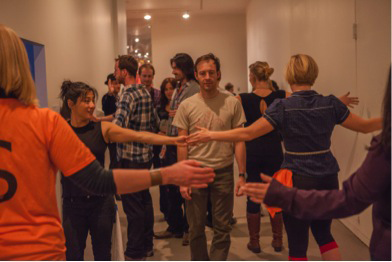
Germaine Koh. League, ongoing since 2012, Participatory Project. Image courtesy the artist.
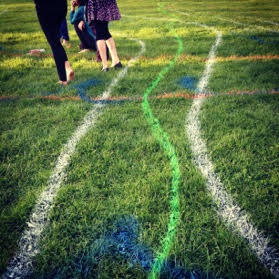
Germaine Koh. League, ongoing since 2012, Participatory Project. Image courtesy the artist.
League borrows familiar games as part of a process of observing the patterns in our everyday lives.[2] The ambiguous and primordial universe of play, sports and games, defined as ‘the voluntary attempt to overcome unnecessary obstacles’,[3] offer the promise of structure. Germaine Koh has deliberately shaped a studio/play space that extends to the surrounding field. Each free League session has a format intentionally designed to be receptive to improvisation; it is an interactive venue for people to play with forms, strategy, and problem solving. League, through a process of negotiation, deconstructs and reconfigures familiar frameworks through play. The vulnerability I feel is a legitimate response to my knowledge of Koh’s wily artistic practice. For example, she has boxed against another artist on a traffic island, turned the act of resting on a park bench into an endeavor that requires balance and socialization, and placed a pole in the middle of a path forcing everyday traffic to carve a new direction into the landscape.[4] Her work transposes a sense of the theatrical to a public space, and creates situations in which the observer, though relatively safe, finds herself in space that provides minimal orientation. The work, by its nature, requires action; most often with others.[5]

Germaine Koh and Jade Rude. HIGH NOON, 2004, site-specific performance. Photo by Michael Klein.
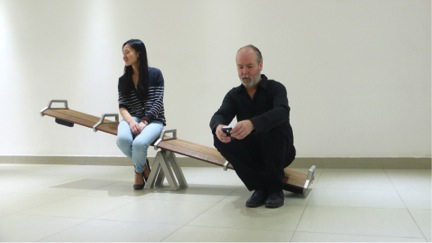
Germaine Koh. SeeSawSeat prototype, 2011, Aluminum and ipe wood structure. Image courtesy the artist.
Art ‘frames the raw condition under which sensations are created, metabolized, released into the world, and made to live a life of their own, to infect and transform other sensations’.[6] Koh’s work frames situations through a minimalist reflection upon an interrupted pattern. It is dramatic and unsettling because the images and the edges of the works are in flux, referencing multiple states of the surrounding world and always pushing and shifting the edges, if only for a moment.
Koh invites you to participate with a sense of active curiosity, to join her in the careful process of observing situations you might otherwise have walked past. The attraction is physical, it taps you on the shoulder and points the observer in a direction as it solicits an embodied response. Tracing Tracks, 2014, is an online game created by Germaine Koh and Edith Flückiger. Players are able to choose from an online inventory of urban paths either by tracing a track manually or syncing a personal GPS devise. Using a geographical frame, the objective of the game is to experience a space through the logic of another location. The word ‘game’ invokes a sense of play, an open and ever shifting process that is influenced by memory, tradition, space, and player interaction. Tracing Tracks invites players to move and reflect creatively about the patterns of path making, their significance, and the deliberate energy required to critically examine the power of the grids we create in our lives.
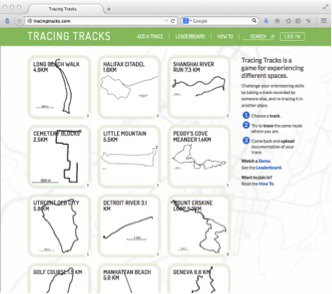
Germaine Koh & Edith Flückiger. Tracing Tracks, 2014, website.
Koh’s DIY Field shifts the frame by inviting observers to create their own pattern while playing with boundaries, colour, light, and movement. Located in Winnipeg’s Central Park, it consists of thirty eight pedestrian-scale LED light posts. The park user controls the three buttons on each pole; one each for red, green, and blue. Combinations of these colors can be mixed within the pole, to create yellow, cyan, magenta, white, and no light. In a park, the poles can index equipment such as goal posts: they can also be giant-sized pixels used to create drawings.[7] The results are a temporary frame that reveals individual animation, and multiple patterns of spatial play.

Koh, Germaine. DIY Field, 2011, Metal posts with LED lights. Image courtesy the artist.
Koh is also known as PLAYER 1 in the Terminal City Rollergirls roller derby league. As in her art practice, while playing roller derby she maintains multiple ideas and actions simultaneously working to achieve a competitive matrix with herself and others. Play is also hard work, consisting of regular practices, and a process of iteration to develop skill and stamina, leaving the player equally exhausted and exhilarated.[8] Both sport and art require an imagination, perseverance, practice, and self-reflection. Part of the training is confronting the discomfort as you pass through uncertainties, conflicts, negotiations, and politics while participating in the process. Experiencing the moment you hit that ‘sweet spot’, if only for a flash, can be addictive.

Image of the artist Germaine Koh (pictured to the left). Copyright Nicolas Charest.
League represents an attempt to communicate the similarities between mental and physical approaches to practice and process. The players are actively involved in a process of nurturing critical and creative thinking. League encompasses the multiple implications of sport and art simultaneously, as Germaine Koh provides an embodied reflection of the subtle yet important patterns and sensations of game play in everyday life.[9]
Many thanks to Laura Marks and Germaine Koh for sharing their expertise and encouragement during the course of this writing.
[1] Salen, Katie & Zimmerman, Eric, Rules of Play Game Design Fundamentals, (Cambridge Massachusetts: The MIT Press, 2004), 95.
[2] Koh, Germaine, League http://league-league.org/.
[3] Suites, Bernard Suits, The Grasshopper Games, Life and Utopia, (Boston:David R. Godine, Publisher, In, 1990), 41.
[4] Dyment, Dave, Stand up and Be Counted: the Quotidian Work of Germaine Koh, (Hong Kong: Para/Site Art Space Ltd., 2004), catalogue of an exhibition at the Para/Site Art Space, Ltd. Hong Kong, 2004, 5.
[5] Gohlke, Gerrit, Feigned Casualness, trans. Mitch Cohen, (Berlin: Kunstlerhaus Bethanien, 2005), catalogue of an exhibition at the Kunstlerhaus Bethanien Gallery, Berlin 2005, 40-1.
[6] Grosz, Elizabeth, Chaos, Territory, Art – Deleuze and the Framing of the Earth, (New York: Columbia University Press, 2008), 18.
[7] Koh, Germaine, DIY Field http://www.germainekoh.com/ma/projects_detail.cfm?pg=projects&projectID=126.
[8] Koh, Germaine, “Checks and Balances,” Art Lies, Volume 61, Spring (2009), 23. http://texashistory.unt.edu/ark:/67531/metapth228026/m1/24/?q=checks and balances.
[9] Marks, Laura, Immanent Domain, (Vancouver: Contemporary Art Gallery, 2001), catalogue of an exhibition at the Contemporary Art Gallery, Vancouver, May 5, 2001 through July 15, 2001.7.
Bibliography
Dyment, Dave. Stand up and Be Counted: the Quotidian Work of Germaine Koh. Hong Kong: Para/Site Art Space Ltd., 2004.
Catalogue of an exhibition at the Para/Site Art Space, Ltd. Hong Kong, 2004.
Gerrit Gohlke, Gerrit. Feigned Casualness, trans. Mitch Cohen. Berlin: Kunstlerhaus Bethanien, 2005.
Catalogue of an exhibition at the Kunstlerhaus Bethanien Gallery, Berlin 2005.
Grosz, Elizabeth. Chaos, Territory, Art – Deleuze and the Framing of the Earth. New York: Columbia University Press, 2008.
Koh, Germaine. “Checks and Balances.” Art Lies, Volume 61, Spring (2009), 22-3. http://texashistory.unt.edu/ark:/67531/metapth228026/m1/24/?q=checks and balances.
Koh, Germiane. DIY Field, http://www.germainekoh.com/ma/projects_detail.cfm?pg=projects&projectID=126 .
Koh, Germaine & Flückiger, Edith. Tracing Tracks,
http://www.germainekoh.com/ma/projects_detail.cfm?pg=projects&projectID=137
Koh, Germaine. League. http://league-league.org/.
Marks, Laura U. Immanent Domain. Vancouver: Catalogue, Contemporary Art Gallery, 2001.
Catalogue of an exhibition at the Contemporary Art Gallery, Vancouver, May 5, 2001 through July 15, 2001.
Salen, Katie & Zimmerman, Eric. Rules of Play Game Design Fundamentals. Cambridge Massachusetts: The MIT Press, 2004.
Suits, Bernard. The Grasshopper Games, Life and Utopia. Boston:David R. Godine, Publisher, Inc., 1990.
Louise Rusch is based in Burnaby, BC where she has more than twenty-five years of experience in the field of Recreation. Awards included the BCRPA Award of Excellence for a community-based children’s circus program. She recently completed her Bachelor of Arts at SFU with a focus on Arts and Culture Studies and Sociology. There she had the opportunity to study under the direction of Dr. Laura Marks and Germaine Koh, which cemented a lifelong interest in the interconnection of the process between art and play. Louise’s current research is on physical literacy and the role public recreation has in encouraging a whole-body approach to living.